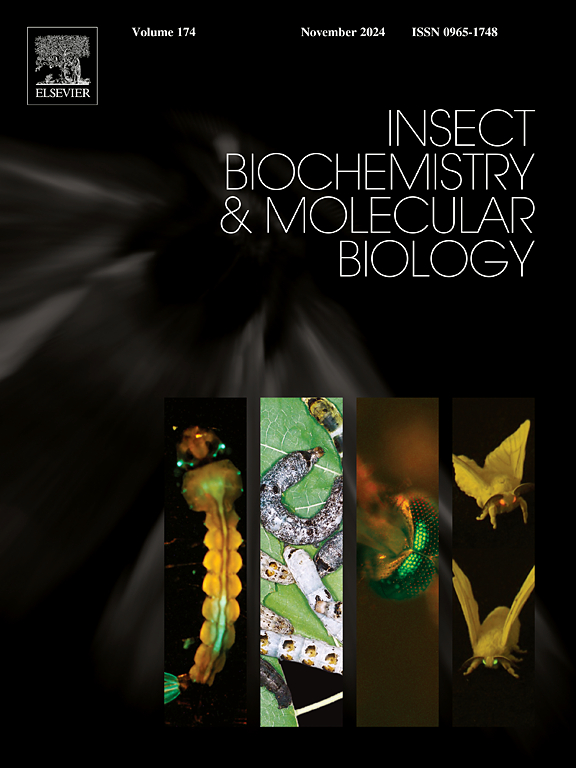家蚕一种辅助pirna通路因子秦的缺失引起的性别偏性生育退化
IF 3.7
2区 农林科学
Q2 BIOCHEMISTRY & MOLECULAR BIOLOGY
引用次数: 0
摘要
piwi相互作用RNA (piRNA)通路是动物性腺转座因子(te)沉默的主要防御系统,可维持生殖细胞的基因组完整性和确保配子体的正常发生。据报道,在鳞翅目模式昆虫家蚕中,piRNA通路因子Qin参与了piRNA的生物生成。然而,秦的生理功能仍有待研究。本研究证明了秦在家蚕两性性腺发育中起着重要的作用。BmQin主要在性腺中表达。免疫荧光染色显示BmQin定位于生殖腺生殖细胞和体细胞的细胞质中。通过CRISPR/Cas9系统敲除BmQin,可诱导雄性小鼠完全不育,雌性小鼠部分不育。值得注意的是,突变体在性腺发育和配子体发生方面表现出严重缺陷。RNA-seq分析显示,突变性腺中piRNA通路失调。此外,突变性腺细胞凋亡显著增加。本研究揭示了BmQin在家蚕生殖力中的生理功能及其在雌雄生殖腺piRNA通路中的辅助作用。本文章由计算机程序翻译,如有差异,请以英文原文为准。

Sex-biased fertility degeneration induced by depletion of an auxiliary piRNA-pathway factor Qin in Bombyx mori
The PIWI-interacting RNA (piRNA) pathway is the major defense system for transposable elements (TEs) silencing in animal gonads, maintaining genomic integrity of germ cells and ensuring proper gametogenesis. An the piRNA-pathway factor, Qin, has been reported to participate in piRNA biogenesis in the lepidopteran model insect, Bombyx mori. Nevertheless, the physiological functions of Qin remain to be characterized. Here we demonstrated that Qin plays important roles in silkworm gonad development of both sexes. BmQin was predominantly expressed in gonads. Immunofluorescent staining revealed that BmQin is localized in the cytoplasm of both germ cells and somatic cells in gonads. Depletion of BmQin via CRISPR/Cas9 system induceed complete sterile in males, and partial sterile in females. Notably, mutants displayed severe defects in gonad development and gametogenesis. RNA-seq analysis revealed that the piRNA pathway was dysregulated in mutant gonads. In addition, apoptosis was significantly enhanced in mutant gonads. Our study revealed the physiological functions of BmQin in silkworm fertility and its auxiliary roles in the piRNA pathway in both male and female gonads.
求助全文
通过发布文献求助,成功后即可免费获取论文全文。
去求助
来源期刊
CiteScore
7.40
自引率
5.30%
发文量
105
审稿时长
40 days
期刊介绍:
This international journal publishes original contributions and mini-reviews in the fields of insect biochemistry and insect molecular biology. Main areas of interest are neurochemistry, hormone and pheromone biochemistry, enzymes and metabolism, hormone action and gene regulation, gene characterization and structure, pharmacology, immunology and cell and tissue culture. Papers on the biochemistry and molecular biology of other groups of arthropods are published if of general interest to the readership. Technique papers will be considered for publication if they significantly advance the field of insect biochemistry and molecular biology in the opinion of the Editors and Editorial Board.

 求助内容:
求助内容: 应助结果提醒方式:
应助结果提醒方式:


